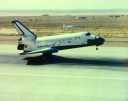Columbia's
Last Flight
It
began on January 16 with a by-now predictable launch.
Columbia blasted off from Cape Kennedy on the 113th space
shuttle launch. It ended in a fiery explosion over Texas on
February 1.
Columbia's
STS-107 was a science-heavy mission, completing 80
experiments, including some badly needed medical ones. It
had a relatively inexperienced crew flying as well, with
four of the seven astronauts taking their first shuttle
flight.
One
of the mission specialists was Kalpana Chawla, the first
Indian-born person to go into space. Another was Ilan Ramon,
the first Israeli in space. Six of the crew were married,
and five had children. (Click
here
to see profiles of all seven crew members.)
Debris
was spread over hundreds of miles, in eastern Texas and into
Louisiana. A cloud of debris cut a wide swath out into the
Gulf of Mexico. Hundreds of people reported finding parts of
the wreckage.
 Officials
now know that just before the explosion, Columbia
experienced a rapid rise in temperature and wind resistance
and that this forced the shuttle's automatic pilot to make
changes to its flight plan. Officials also know that the
shuttle suffered damage to its left side. Whether this
damage is connected to minor damage the shuttle suffered on
launch day has yet to be confirmed. NASA officials, careful
not to jump to any unsupported conclusions, said that no
connection had been established. Officials
now know that just before the explosion, Columbia
experienced a rapid rise in temperature and wind resistance
and that this forced the shuttle's automatic pilot to make
changes to its flight plan. Officials also know that the
shuttle suffered damage to its left side. Whether this
damage is connected to minor damage the shuttle suffered on
launch day has yet to be confirmed. NASA officials, careful
not to jump to any unsupported conclusions, said that no
connection had been established.
Soon
after this rise in temperature and wind resistance
occurred, NASA's Kennedy Space Center lost contact
with Columbia. Traveling at 12,000 mph, the shuttle
then blew apart, sending bits and pieces flying in
all directions.
Independent
commissions have been formed to investigate the explosion
and the events surrounding it. Some people either heading
these commissions or who will be asked to contribute are the
same people who helped with the investigation of the
explosion of the space shuttle Challenger in 1986.
 NASA
officials, with President Bush and other government
officials in firm agreement, said that the shuttle program
was on hold only and that future flights would take place.
It wasn't clear when. Space shuttle Endeavour was scheduled
to launch on March 1. Still, unlike 1986, this time around,
the sentiment was overwhelmingly in echoing the words of
NASA's Shuttle Program Manager Ron Dittemore: "We will find
the program, we fill fix it, and we will move on." NASA
officials, with President Bush and other government
officials in firm agreement, said that the shuttle program
was on hold only and that future flights would take place.
It wasn't clear when. Space shuttle Endeavour was scheduled
to launch on March 1. Still, unlike 1986, this time around,
the sentiment was overwhelmingly in echoing the words of
NASA's Shuttle Program Manager Ron Dittemore: "We will find
the program, we fill fix it, and we will move on."
Graphics
courtesy of ArtToday
|